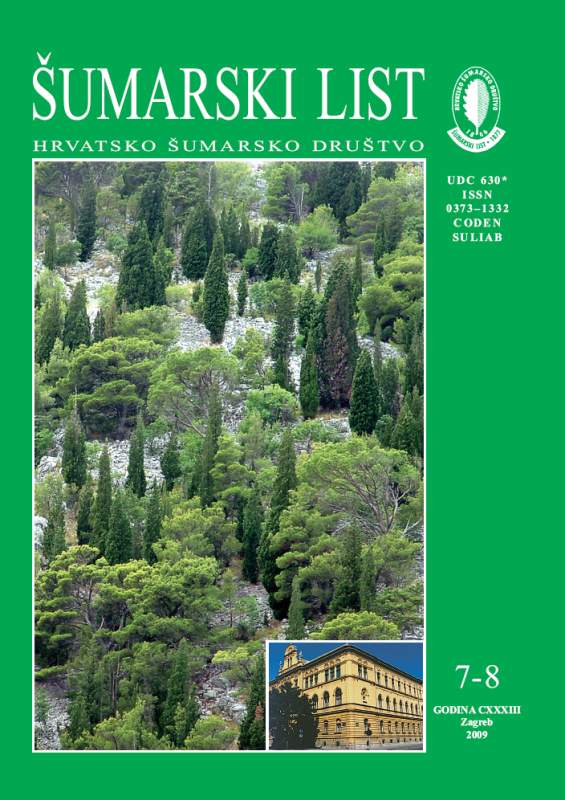
broj: 7-8/2009
pdf (8,4 MB) |
|
||||||||||||||
| RIJEČ GLAVNOGA UREDNIKA | ||
| Branimir Prpić | ||
| MORE ABOUT FORESTS AND NATURE PROTECTIONIN RELATION TO NATURA 2000 IN CROATIA pdf HR EN | 368 | |
| Classification of forest ecosystems and their habitats into the national ecological network in the continental part of Croatia was performed very successfully; however, in the Mediterranean part the task was made more difficult by the degraded condition of the forest vegetation. Since the continental part abounds in forests managed on a close-to-nature principle, it would be opportune to raise as many high forests as possible of holm and pubescent oak in the Croatian part of the Mediterranean within the NATURA 2000 ecological network. These forests could be raised from both degraded forests with preserved parts of the ecosystem (maquis, pubescent oak scrub), and from pine cultures with naturally occurring autochthonous species. This would considerably increase the non-market value of these forests. Croatian forests managed on a close-to-nature principle represent an exceptional asset for Europe, owing in the first place to their numerous non-market functions, in particular those associated withnature protection. In addition to the FSC forest certification, the technologies used by the Zagreb School of Silviculture ensure biological diversity in naturally managed forests equal to biodiversity in virgin forests, which further enhances their naturalness. The 250-year history and hard work of the forestry profession in Croatia has resulted in a number ofpositive benefits currently attributed to Croatian state forests. Would it not be logical, therefore, that the task of caring for the national ecological forest network in Croatia is given to this profession? I should stress that as a profession we are very well organized and adequately trained, as testified by the composition and structure of Croatian forests, of which every single one could be proclaimed a national park under the European criteria. We, instead, are competing in giving areas with forests as basic phenomena the status of protected areas. We are establishing new administrations but hesitating to employ professional foresters, because “all they do is cut down forests”. We, in fact, arethrowing away money which is short anyway, instead of gathering specialists from different fields (foresters, biologists, veterinarians, sociologists) in the joint task of nature protection. Every forest keeper is well trained in all those forest matters which aranger (a professional term taken over from the USA) is supposed to know. We are spending considerable means on educatingrangers despite the fact that our forest keepers, who care for tree phenophases and forest wildlife, are already well trained and equipped for the job. I speak on behalf of the forest profession and suggest that representatives of the State Institute of Nature Protection and forestry professionals sit down at the round table and use NATURA 2000 as an opportunity to reach a satisfying agreement on nature protection in the Republic of Croatia. I would like to remind the readership that the issue of Forestry Journal 1–2/2008 already tackled the possibility oftranslocatingthe State Administration for Nature Protection from the Ministry of Culture to the Ministry of Forestry, Regional Development and Water Management. This would undoubtedly eliminate various misunderstandings related to nature protection in forested areas and the role of biologists in the protection of forest ecosystems. Or is it more convenient to live in the shade of a minister who, overwhelmed by the enormity of workin his field, finds little time for nature protection? Emeritus Professor Branimir Prpić, Ph.D. | ||
| IZVORNI ZNANSTVENI ČLANCI | ||
| Vedriš,M., A.Jazbec, M.Frntić, M.Božić, E.Goršić | UDK 630* 529 (001) | |
| Precision of Structure Elements’ Estimation in a Beech – Fir Stand Depending on Circular Sample Plot Size pdf HR EN | 369 | |
| Matošević,D., M.Pernek, T.Dubravac, B.Barić | UDK 630* 453 (001) | |
| Research of Leafminers onWoody Plants in Croatia pdf HR EN | 381 | |
| Dubravac,T., S.Dekanić | UDK 630* 423 (001) | |
| Structure and Dynamics of the Harvest of Dead and Declining Trees of Pedunculate Oak in the Stands of Spačva Forest from 1996 to 2006 pdf HR EN | 391 | |
| Godina, K. | UDK 630* 569 (001) | |
| Development Structure Elements in Mixed Oak Stands in Aria of ForestAdministration Bjelovar with Retrospect on Modelling Growth andYield of Mixed Stands pdf HR EN | 407 | |
| Cerovečki, Z. | UDK 630* 188 (001) | |
| Beech Forests and Milava –As.Calamagrosti arundinaceae-Fagetum(Ht. 1950) Cerovečki ass. nov. of the Mountain of West Croatia pdf HR EN | 417 | |
| STRUČNI ČLANCI | ||
| Pašičko,R., D.Kajba, J.Domac | UDK 630* 425 (biomasa–Biomass) | |
| Impacts of EmissionTrading Markets on Competitiveness of Forestry Biomass in Croatia pdf HR EN | 425 | |
| Grgurević, D. | UDK 630* 272 (Cactaceae) | |
| Succulents (fat plants) on theAdriatic Coast and their Use in Parks pdf HR EN | 439 | |


